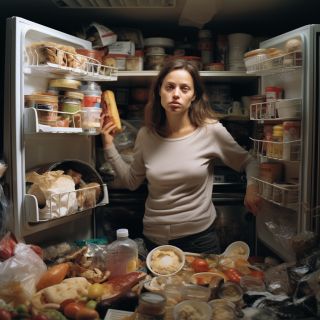Three food hoarders are in my immediate circle of friends and family. In fact, there may be more, but I don’t know about it because I don’t know them well enough.
One of these food hoarders, who labels herself as such, asked me to write about the subject. This request seemed like it would be easy. It is a natural segue from composing a script about hoarding to one about food hoarding.
Wait—not so fast!
Though it seems as if the subject should be easy, research on human food hoarding is sparse. In fact, it is almost nonexistent. Fortunately, there is more on animals that hoard.

A food hoarder taking stock of her abundant supplies.
Source: Midjourney
Still, assuming that the findings from animal research would apply directly to humans is problematic. Here, I do that as little as possible. Rather, I concentrate on what little has been written about human food hoarding, though some of it is not well-substantiated. Nevertheless, the logic makes sense.
From 2 to 6 percent of the population hoard. Food hoarders are within this group. Specifically, how many is apparently undetermined. Based on my own experience, I would say quite a few.
One of the reasons humans hoard, of course, is the fear of a shortage of needed items. We saw this recently during COVID-19. In this case, buying in excess was simply a precautionary measure to protect oneself and one’s family. However, when first-world resources are abundant, food hoarding is unnecessary. Still, people do it.
The supposition is that this behavior is motivated by anxiety, depression, insecurity, obsessive-compulsive disorder, or past trauma. In my literature search, I could not identify any scientific studies, especially those supporting the reason for human food hoarding, but those from the lay literature certainly make sense.
In animals, food accessibility is the most important factor affecting food hoarding. For example, if hamsters are food deprived, they hoard food. This state can be artificially induced when these animals are given systemic injections of ghrelin, a hormone that increases during fasting. This stimulates a chemically induced food-deprivation state, resulting in food hoarding. Other animal food hoarders that have been studied include tree squirrels, chipmunks, moles, woodpeckers, ants, and corvids.
It is interesting to think of food hoarding as storing food externally rather than internally in the form of body fat. In the latter construct, we carry the surplus with us rather than storing it outside ourselves. This way, we won’t have to remember where we put what was stored, which is an advantage.
Of course, the downside of all this hoarding is that more food is saved than can be eaten. It spoils, resulting in a waste of resources. Not only can this be a financial burden to the person who purchases it, but the food is blocked from being consumed by others who may need it.
Summary
Food hoarding among animals has been scientifically studied and is influenced largely by insecure resource availability. On people exhibiting this behavior, however, research is scarce. Possible psychological motivations for food hoarding in times of abundance include anxiety, depression, and past trauma. Our relative lack of understanding of this phenomenon highlights the need for focused research to attempt to alleviate these issues.
